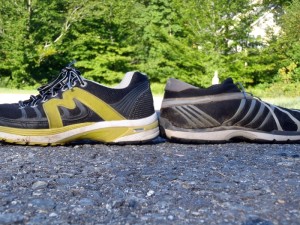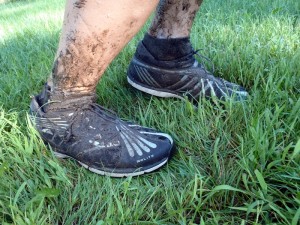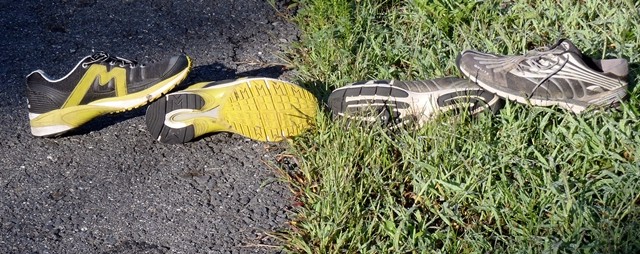(Editor’s Note: Here at EasternSlopes.com, for every product we test, we dig deeper, take more time, get beyond manufacturer’s claims, and find out how they really work for us in our world. And we give you the details on when, where and how a product was tested. We hope this level of detail will help you assess how a product might work for you in your world. If you have any opinions on the products we’ve tested, please add a comment.)
I hate to run. Nothing philosophical; it’s simply that running hurts more than anything else I’ve ever done. Unfortunately for me, running aggravates an old shoulder injury. Pain in my legs is one thing, but the throbbing caused by every heel strike has made longer runs nearly impossible for years.
But some of the things I love to do require running. Cyclocross and “crazy style racing” (adventure races, obstacle courses, that type of thing) definitely work better when you’ve trained…and it’s in the training that the real pain happens. During a race, adrenaline and endorphins make it easy to ignore the pain, but when you’re trying to bang out a few miles to make sure you CAN run in the race, that’s when it can be almost intolerable.
With that in mind, I decided to see if there was anything that could solve my problem. I tried what seemed to be the most logical thing to do, which was to find shoes with really thick, soft heels; clearly, those would reduce heelstrike, cushion the blow, and save my poor shoulder. Logic, however, has never had much to do with my life. The cushiest shoes I could find from top manufacturers like Nike, New Balance, and Adidas didn’t help in the slightest. Could the answer lie in the other direction?
Testing Adventure Racing Shoes: GoLite’s “BareTech” & Karhu’s “Fulcrum”

Seeking out oddball technologies is something we specialize in at EasternSlopes.com, and, in this case two manufacturers stood out as claiming to look at running mechanics very differently, both from the herd of manufacturers and from each other. GoLite, with their BareTech, channels the current movement toward “barefoot” running and hiking, but with a twist. Rather than creating a thin covering for the foot with no cushioning, they created a last that supports the foot and arch fully, but with no difference in thickness throughout the system. This, to us, seems a sensible application of the barefoot concept; our bodies may have evolved to run without heel lifts, but they didn’t evolve to run on pavement or rock-hard trails that countless other people run on. Softer ground would certainly allow running with more comfort (as anyone who has run barefoot in sand will agree); why not let technology adapt us to the changes we’ve made to the environment?
Karhu, on the other hand, goes the exact opposite direction with their Fulcrum design. They use a higher than average heel, with more drop to the forefoot. Coupled with the patented shaping of the midsole, their goal is to get you off your heel and onto your forefoot as quickly as possible, moving you forward rather than up-and-down. Their goal is to make you faster by reducing wasted vertical energy. Makes sense, in theory…but theory often doesn’t work in the field. And, regardless of speed, would either their technology or GoLite’s help MY specific problem?
Time for real-world testing for these adventure racing shoes. I started using a pair of Karhu Stable Fulcrum Rides ($84; 26 ounces); they seemed to be a good choice for training, as they’re designed for stability and longevity rather than absolute rock-bottom weight. Karhu has a long tradition of running shoes; in the USA, they’ve long been known as a cross-country ski company (which, by the way, they are no longer), but, in fact, they started as a shoe company (actually, they produced javelins and discuses in 1916, 4 years before they started making shoes, but who’s counting?). The Fulcrum technology has been around since they patented in in 1986; if they’ve stuck with it for 25 years, it must be working for someone. And, it appears that it’ll particularly work for people with large feet; I tried on my usual 10 1/2, and simply couldn’t tighten the laces enough to keep my feet from swimming in them. Dropping a half size produced a nice fit; still plenty of room, but easily snugged down comfortably. The initial run seemed positive; after a mile and a half, no obvious shoulder pain.
So far, so good. Time to try the GoLite FlashLites ($110; also 26 ounces). Since they’re a more trail-biased design, I decided to take them out into the woods. First, though, I had to get the fit right. Like the Karhus, these run to a pretty high internal volume. Their PreciseFit system has a variable pad under the forefoot; the bigger your foot, the smaller the pad. And, it works…to a point. I was able to get the volume correct in the forefoot area, but it felt a little sloppy in the heel area. So, I added a thin, flat midsole to take up some volume; problem solved. Once that was dealt with, the shoes fit very well, with an excellent heel pocket (extremely important so your shoes stay on when you’re doing races like the Tough Mudder!). Off to the woods, and a relatively short run; given the totally different stance of these over any other running shoes, I didn’t want to take a chance on injuring myself before my body adapted. The feeling was somewhat different, but not totally alien; at the beginning, I actually felt MORE heel strike, as I was lifting my feet a little higher than needed to compensate for a “normal” heel and landing flatter on my heel, but once I adjusted, the feeling became smooth and forward. And, at the end of the run…no shoulder pain!

Hmm…there’s something wrong here. BOTH shoes were working for me, and they absolutely, positively shouldn’t…based on a logical approach. But, when logic doesn’t seem to work, it’s time to figure out why; usually, it means I’m looking at the system in the wrong way.
Over the following months, I traded back and forth between the two shoes, and found out a few things. The first was that on pavement, I definitely preferred the Karhus. The GoLites worked, and worked well, but the extra cushioning on that hard a surface gave the edge to the more traditional sole. Still, I didn’t get the throbbing shoulder pain from the GoLites on pavement, so whatever had worked in the woods still worked on pavement. Second, in the woods, I preferred the GoLites. The thinness of the sole, which was somewhat of a detriment on pavement, meant the shoes really conformed to trail irregularities; that, coupled with the soft GripStick rubber outsole allows the shoe to feel remarkably secure on loose surfaces. They quickly became the “go-to” shoe for our adventure races, even more for that grip than for their light weight (trail runners are heavier than road shoes, so even though they’re the same weight as the Karhus, they’re “lighter” for a woods shoe). The Karhus were surprisingly competent in the woods, but their bias is toward harder surfaces. If I were planning to do both runs in the Wildman Biathlon, the Karhus would be my choice for the first run, the GoLites for the second.

So, it was a joy to find that there ARE shoes that allow me to run without the throbbing shoulder problem (in sort of a sick way; just because my shoulder doesn’t throb doesn’t mean that the rest of my body doesn’t hurt while running!). But, the question still remained…since they’re literally on opposite sides of the norm, why doesn’t one work better, one work much worse? Since the obvious paradigm didn’t appear to make any difference, time to shift.
And, after a lot of measuring, thinking, swearing, sweating, and generally wondering if I was nuts (Editor’s note: he is.), I finally found one area where they were similar to each other AND significantly different from the half dozen pairs of conventional running shoes hanging around the house. The conventional shoes have heels that are very thick and soft, all the way back to effectively BEHIND the heel pocket. Makes sense…start cushioning the shock early. Both the GoLite and Karhu, on the other hand, have a more steeply “rockered” (to borrow a term from the ski industry) heel at the back. Looking at them from the side, it seems like that would create a smaller amount of surface area and increase the heel strike, exacerbating the shock going up through your body and into your (or my) shoulder.

Think about the running stride, though. As you begin to land on your front foot, it’s well in front of your center of mass; as your body moves forward, your mass starts to shift over your forefoot, which is where you’ll ideally take more of the weight. Since the forefoot is a lever that can absorb shock using the flex of your ankle, the severity of the shock will be limited if you can get more of your weight to land there rather than on the heel. Thus, a design that gets you off your heel and into your forefoot more quickly would utilize that hinge better. A thicker heel on the shoe behind the natural curve of your own heel would, though, seem to move more of the impact behind the hinge area, to where it shoots up through your body with only the cushioning of the shoe, not the hinge.
So, since the “barefoot” movement is focused on forefoot running, let’s see what the GoLite appears to be doing. The steep rocker at the heel means no significant contact or shock as you start to bring your foot down and your mass moves over your foot. Then, as you land, your weight is distributed throughout your foot, particularly on the forefoot area which allows the ankle hinge to dissipate the shock over a longer time. There’s not no heelstrike; I certainly found that my heel was still a significant part of the running motion. It’s just simply a lot less, and while the time lag of strike going through you NOW as your heel hits versus spread over the time from your forefoot starting to make contact to when you reach the bottom of the ankle hinge and start to rebound is measured in milliseconds, it doesn’t take a lot of deadening the initial shockwave to provide a lot of relief; just ask my shoulder.
But if the GoLite model makes sense, how can the Karhu work? It would seem that a heel shape that’s more conventionally thick–in fact, thicker than the average of the “conventional” shoes–would limit the advantage of the rockered heel. But, remember that the Fulcrum design is aimed specifically toward getting you onto your forefoot as quickly as possible. Sounds good, anyway, but how does it work? More headscratching and measuring…ah. The Karhu heel is higher, but also steeper and shorter front-to-back; it’s almost like landing on a ball. As soon as you start to land on your heel, you’re effectively catapulted forward onto your forefoot. So, as with the GoLite, you still make contact first on your heel, but only spend a tiny amount of time there, moving onto the forefoot quickly to take advantage of the lever. Put differently, GoLite uses the simple mechanics of letting your body/foot relationship in shoes be as close to the way we evolved as possible; Karhu takes a more active role by using a design that forces a quick transition. But, either way, the same goal is attained…the shoe naturally gets you onto your forefoot faster, without you making a major conscious change to your running style.
And, of course, getting you onto your forefoot faster should make you run faster. Think about turbocharged and hi-revving engines vs. conventional ones. Both get you more power out of a small package than conventional, but they go about it in different ways. And, in this case, both Karhu and GoLite are trying to take advantage of that lever/spring action to get more speed. But, in my personal case, the effect is different; I’m gaining a comfort advantage, which is more important in my situation. You simply CAN’T be fast if you don’t run; I’m still not fast, but I’m one heck of a lot faster than I was when all I did was look at my running shoes! Am I actually faster than I would be with a conventional shoe? No idea, and I frankly don’t care; in my own particular circumstances, the simple fact of being able to run is more important.
It’s clear that there’s no “one size fits all” solution for every runner’s needs; it’s one of the reasons why there are so many shoe companies out there, and so many different models, lasts, designs, etc. Would the GoLite BareTech or Karhu Fulcrum make you a faster runner? Would either of them reduce your personal aches and pains? I can’t answer those questions for you; nor do I know which is more important to you. But what I CAN say with certainty is that they offer significant design differences from “the big guys”. Are they design advantages? For me, unquestionably. I still grumble about going out to run, but I no longer cringe at the thought. Strangely enough, they’ve been exceptionally complementary for my adventure racing; the Karhus have allowed me to head out the door and run on pavement when I don’t have the time to drive to the trails, and the GoLites have been an ideal race shoe. Until some new and better (for me) technology comes forward, I can’t imagine being without either!



David,
I like your analysis comparing the two shoes and why they each worked for you. However, the concept of barefoot running (or walking) includes the greater ability for proprioceptive information utilization to adjust foot and ankle usage (the entire body, for that matter) due to the greater ability to feel the ground with thinner soles and heels on the shoe. Neither of the models you tried allow for this so I’d suggest that they do not take the concept of barefoot running into account accurately. And, I am not much of a runner.
Have you tried Vivo Barefoot shoes for walking or running. They also encourage greater use of the mid-foot and ‘spring’ action dynamics of the foot to allow ease of walking. Admittedly, they do require wearers to learn a new way of walking,and, as a physical therapist, I think this is a good thing. We tend to be very lazy walkers given the typical poor design of most shoes. They just do not allow us to use our feet properly.
Dave
Dave, thanks for the comment! The proprioception comment makes sense to me; even though the GoLite isn’t entirely barefoot, the feedback on the ground contours through that thin sole definitely made running on varied terrain feel more confident, so I would imagine an even thinner sole would enhance that characteristic. Haven’t tried the Vivo Barefoot, but they look interesting…who knows, maybe we’ll be reviewing them soon! A question for you in return…how difficult do you find it typically is for someone to learn the new way of walking/running?